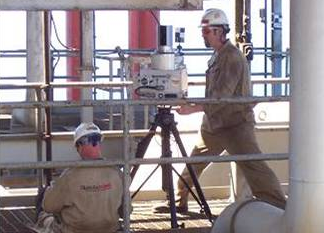Quantapoint’s Eric Hoffman on the service provider’s role
HOUSTON – As far back as 2004, the first time SPAR interviewed Quantapoint CEO Eric Hoffman, his company had already completed some 500 laser scanning projects. And he was already emphasizing the value of the service provider in the 3D data collection process:
“Just collecting the data alone won’t let you get your work done,” he told Bruce Jenkins at the time. “The end purpose of the data is to improve your work process. Does the service provider support the data afterward? Will they train your people in how to use it? Will they provide phone support if you have a problem with the data? Just scanning is not all of the business. If that’s all we did, we wouldn’t succeed.”
It’s a message he echoes to this day: “My job is to take this information and help you use it, be a trusted advisor,” he said. “Laser scanning by itself isn’t what [asset owners and facility managers]need. They need a way to make good decisions from it.”
This is a message Hoffman is concerned the industry still isn’t hearing. “Current technology is trending toward faster and cheaper,” he said at the recent FARO 3D Documentation conference, “rather than better and smarter … The data collection is trending toward a commodity, but what we do is not a commodity. It’s a skilled trade. You have to know the why. What’s the end deliverable I need to make?”
He said much of the talk in the industry about laser scanning being a “disruptive” technology may not be considering the actual job of those folks running things like power plants and refineries. “The facility owners are the least disruptive people out there,” he said. “They want consistency … The information you’re collecting has to live for the life of the facility. Will it still be in the same format five years from now? I can’t even use the same drive right now I used five years ago.”
Hoffman is further concerned that software advances and innovation aren’t grounded in the reality of a functioning facility. “Knowledge loss through digital sampling isn’t so important with a statue you’re trying to recreate,” he said, “but a facility is something that moves and breathes, and when you sample it, you lose that information and can’t gain it back. The uncertainty in that digital data needs to be accounted for.”
As an example, software that seeks to add automation to the modeling process could cause significant harm if not used correctly, he cautioned. “Was that pipe bent,” he asked rhetorically, “because of original design error or did they intend to do that? If you just use algorithms, they don’t always match the design intent. You have to involve the asset owner … They’re generating a lot of assumptions that can’t be traced back to reality again.”
Ultimately, the service provider and the asset owner are in a long-term partnership, when the relationship is working well. Service providers who see their job as providing information that allows those asset owners to make good decisions about their facilities, however that information is gathered, will be successful, Hoffman said.
“The facility owner doesn’t care about laser scanning.”
To hear Hoffman speak about “Evaluating model uncertainty and its effect on decision making,” visit SPAR International, April 15-18, in Houston.






